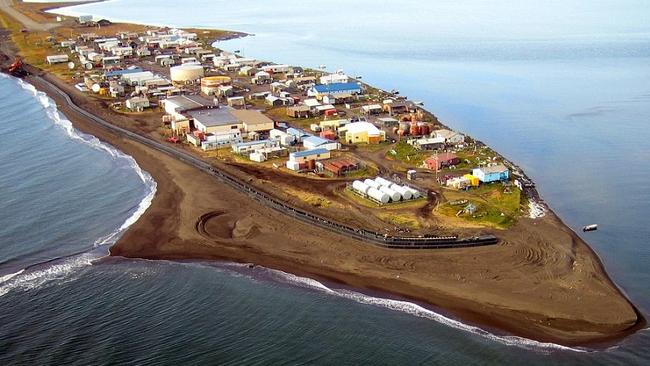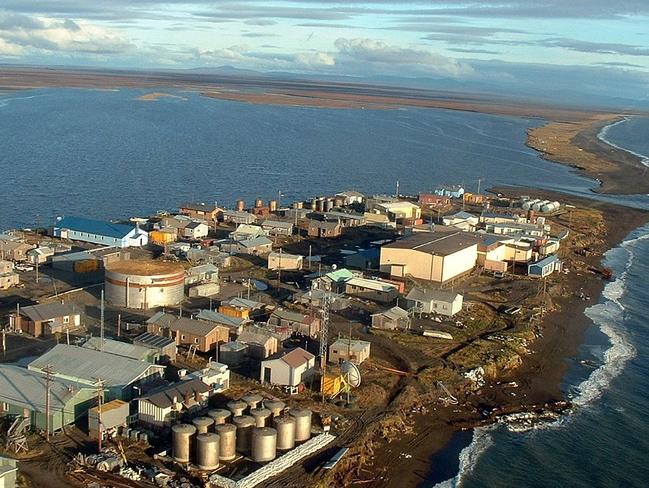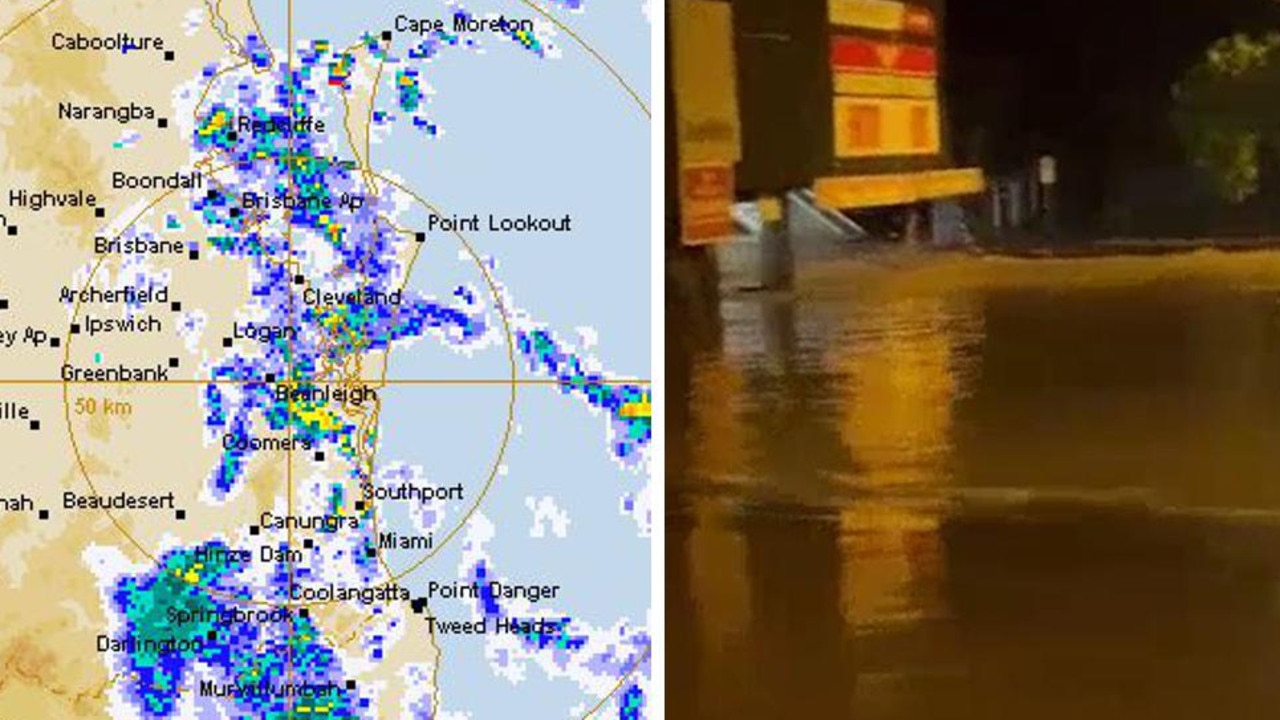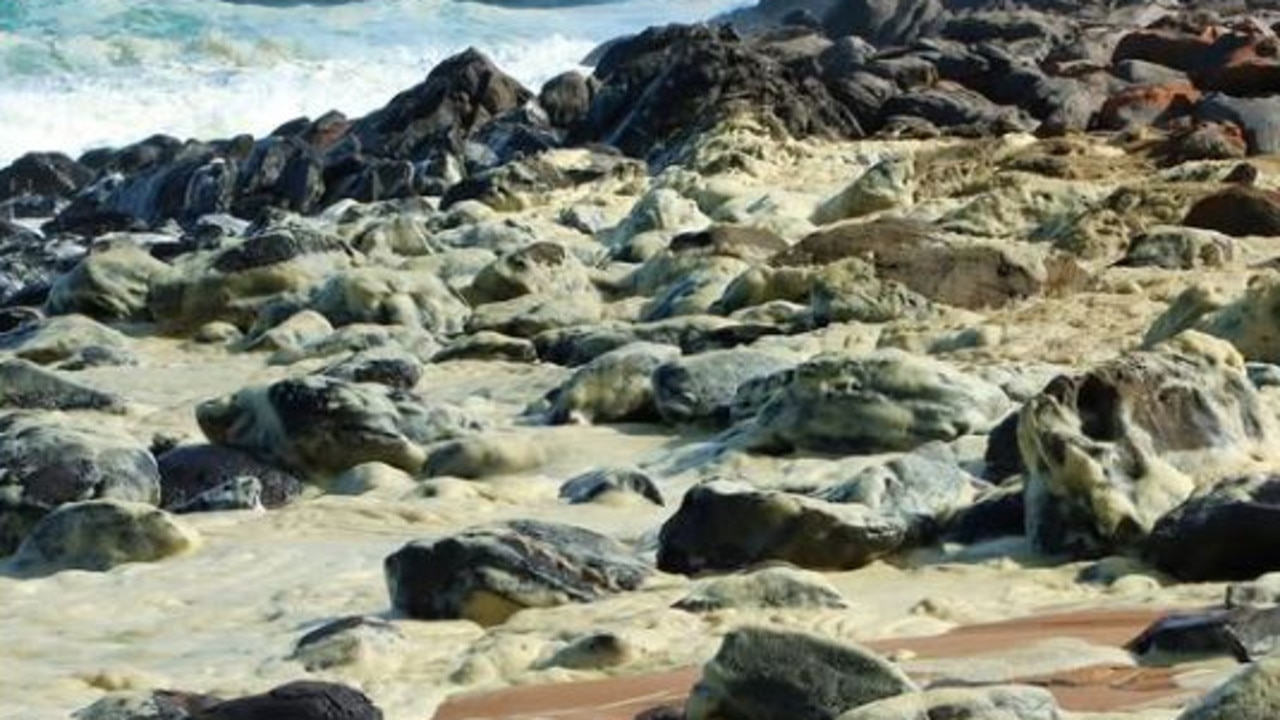Small Alaskan island Kivalina expected to be covered by water within 10 years
WITH each passing storm, a tiny Alaskan island sinks further into the sea and further into oblivion.

WITH each passing storm, a tiny Alaskan island sinks further into the sea and further into oblivion.
Soon those who call it home will have to pack up their things and leave. The school will be under water. So too will the handful of homes that litter the black sand bordering the unforgiving Chukchi Sea.
Four-hundred people call Kivalina home. Shelby, a 13-year-old girl, is one of them. She says “the ocean is slowly eating away our island” and she’s not being a melodramatic teenager.
Experts say Kivalina, which at its highest is four metres above sea level, will meet its watery grave within 10 years. The island that was once home to eskimo villagers will exist only in photographs and stories.
Around the island, villagers have built rock walls and used giant sand bags to hold back water. Previously a natural ice barrier formed during the colder months to do the job for them, but warming temperatures mean the ice forms later and melts earlier each year.
Hundreds of kilometres to the south another small community is changing before its inhabitants’ eyes. Newtok, Alaska, home to 350 people, is losing as much as 30 metres of flat land a year, locals say.
Closer to Australia, small Pacific island states like Kiribati and Tuvalu are suffering similar fates.
Populations who’ve lived on these islands for centuries are becoming part of a 21st century phenomenon. These are the climate refugees.

‘HOUSES ABOUT TO TUMBLE INTO THE WATER’
Millie Hawley lives on Kivalina and says life has changed dramatically in recent years. A number of homes, she says, are in imminent danger of tumbling into the water.
Ms Hawley told the LA Times locals are struggling. Previously they depended on seal meat to sustain themselves but now they buy everything from a local store. Items are flown in and prices are through the roof.
“Usually we get 80 to 100 seals for the whole community,” she said. “This year, we were looking to get eight. The community now has to go without dried meat and oil.”
For generations, Alaska’s native Inupiat people have hunted bowhead whales from camps atop thick ice stretching out from the town’s perimeter. That, sadly, is a thing of the past, far too dangerous to even contemplate these days.
Kivalina elder Joseph Swan told a town meeting earlier this year that “the ice does not freeze like it used to”. He said it used to be 10-feet thick.
“Global warming has caused us so much problems,” Mr Swan said.
The shrinking island means space is at a premium for the living and the dead. According to the Times, residents who die on the island are flown to the mainland “so the ocean won’t encroach upon their graves”.
The US Government is well aware of the problem. Despite that, no sitting president has ever visited during his term in office. That could change this week if President Barack Obama stops by on a trip to the Arctic.
For his part, at least he is talking about it. On Saturday, in his weekly address, the president said: “Alaska’s glaciers are melting faster, threatening tourism and adding to rising seas. If we do nothing, Alaskan temperatures are projected to rise between six and 12 degrees (fahrenheit) by the end of the century.”
That, experts say, will be catastrophic. They say there’s no doubt the mess Kivalina residents find themselves in is a result of human behaviour.

‘WE’VE KNOWN ABOUT THIS FOR 25 YEARS’
Kivalina consists of 85 homes, a post office, a school, an airstrip and the local store. Washington Post journalist Chris Mooney visited in February. He described a population leading simple lives.
“Complete wolfskin hangs outside one home; towards the frozen beach, a group of sled dogs tied to tethers,” he wrote. “Elsewhere, a jettisoned car is half buried in snow. The villagers live in cramped conditions without running water in most buildings, and have to haul their own trash and sewage to dump sites.”
It’s a lifestyle that appears set in stone but it can’t last forever.
Professor Ian McGregor from the Institute of Sustainable Futures says Kivalina is not alone. He says small islands are already being swept away and none of what’s happening to Kivalina, Kiribati or Tuvalu should come as a surprise.
“Global warming is causing sea level rises, water expands as it gets hotter. Scientists have been telling us this for 25 years,” Prof McGregor told news.com.au.
He said extreme weather events should force leaders, including our own Prime Minister Tony Abbott, to take the issue seriously.
“On Tuvalu, the average height above sea level is 3-4 metres. It varies from island to island but an island in the Solomon Islands has already become uninhabitable. It’s damaging that the Abbott government still takes (climate change deniers) seriously. Australia has been a laggard, it’s never been a true leader on this issue.”
For its part, Australia has proposed a 26 per cent cut to emissions by 2030, based on 2005 standards. That proposal is expected to be scrutinised at a climate change meeting in Paris in December.
Professor Colin Butler from the University of Canberra says it’s not enough. He says Australia should take the issue seriously because it is not immune to rising seas. Maybe not in 10 years, but maybe in the next century.
“We might be heading into a new dark age, not in the next five years but maybe in the next 100 years,” he told the ABC.
“We’ve got to put far more effort onto slowing down the pace of climate change, rather than deluding ourselves to the idea that we can adapt to it. I’m very concerned that within 100 years there will be devastation through multiple interacting pathways — more expensive foods, sea level rise, migration.”
On Kivalina, locals are living through it right now. Local woman Millie Hawley told the LA Times leaving for the Inupiat people is inevitable but will mean leaving behind a part of who they are.
“(It would be) like asking us not to be a people any more,” Ms Hawley said.




